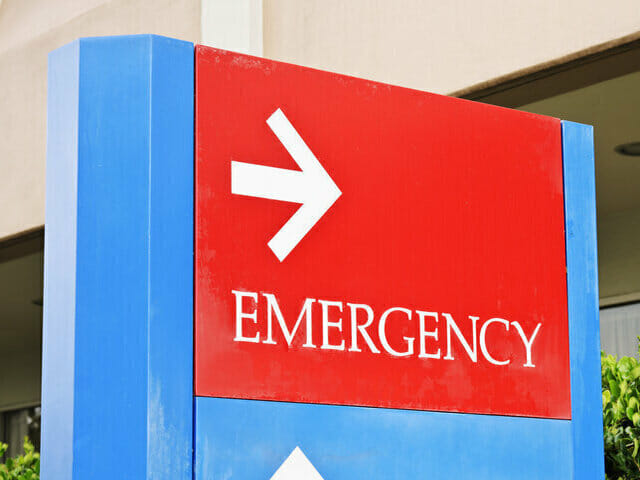Being involved in a motor vehicle accident is an overwhelming experience. A serious car wreck can present devastating injuries, and not obtaining immediate medical treatment can be fatal to your well-being and personal injury claim.
Even if you don’t think you need medical treatment because your injuries seem minor, don’t make the mistake of not seeking medical care immediately. Regardless of the injuries you sustained, you should seek medical treatment shortly after the incident. In some cases, leaving an injury untreated may turn out to be devastating. Take for example, the injured driver who thought his headaches would go away by taking an aspirin, but later turned out to have a severe traumatic brain injury. What was thought of as a minor injury turned out to be a serious one.
You have several types of medical care that you can choose from – the Emergency Room (ER), an Urgent Care clinic, and your primary care physician. Knowing where to go can sometimes be a difficult decision to make. If you have a life-threatening injury, the proper place for you to go is the Emergency Room. If your injuries are not life-threatening, you may consider going to an Urgent Care clinic if your primary care doctor is not available.
If you or a loved one have recently been involved in a motor vehicle accident and have sustained serious injuries, talk to one of our attorneys at Terry Bryant to learn more about your legal options. For a free consultation, call the Terry Bryant law firm at 713-973-8888 or toll-free 1 (800) 444-5000.
Every second counts in a life-threatening situation, going to the ER may be your best bet.
What is an Emergency Room?
Emergency Rooms are facilities that provide high quality medical treatment for life-threatening injuries and trauma. Emergency rooms are open 24 hours a day, seven days a week. They have licensed doctors on site and are equipped to handle complex situations, such as traumatic injuries from a car accident.
There are two types of Emergency Rooms: a Hospital-based Emergency Room and a freestanding Emergency Room. Hospital-based ERs are sometimes referred to as “Emergency Departments,” as they are the departments within hospitals that focus on providing immediate care to patients with life-threatening injuries. Freestanding ERS are not physically attached to a hospital, but they can still provide the same high-quality of care, are open 24/7, and have licensed doctors on site to handle emergency situations.
If you arrive at a free standing ER, how can you confirm whether it’s an actual ER and not an Urgent Care clinic?
First, you may find the word “emergency room” in its title. Upon arrival, you can also ask the staff at the front desk and they will be able to confirm. If the establishment is an ER, the medical establishment will have high-quality technology that will allow computerized tomography (CT) scans, magnetic resonance imaging (MRI), or X-rays to be taken of you, as needed. The ER should have an operating room and be equipped with surgeons and personnel to perform surgeries.
When should I call 911?
Following the incident, if you cannot move and call for help without hurting yourself, stay still. Someone on the scene will most likely may have already called 911. Wait patiently for help to arrive. If you are physically able to drive yourself to an emergency room, you should proceed with caution.
If you feel disoriented, and your vision has become impaired since the incident, you’re not in a position to drive. It’s better to be safe than sorry. Based on your particular circumstances, calling 911 to help you get transported to the ER may be the safest route to take. Being transported by paramedics to the ER can also have an advantage with regards to your personal injury case. Insurance companies will have a harder time asserting that your injuries are not serious if you were transported by EMS.
For all life-threatening injuries, being transported by EMS may be the better decision because paramedics can often start treating on the way to the hospital.
What’s an Urgent Care Clinic?
Don’t let the word “urgent” in Urgent Care fool you. An urgent care is not a synonym for emergency care. In a situation where you may have visited the ER but were not admitted, you may find yourself going to an Urgent Care clinic if your primary care doctor is not available.
Urgent Care clinics do not have operating rooms and they do not have high-quality technology to conduct tests, other than simple lab tests, and maybe X-rays. Urgent Care clinics are open late and on weekends, but they handle non-life-threatening situations.
Aside from the level of care provided at each establishment, what are other differences between the ER and Urgent Care?
- Costs. The bill from the ER visit will be higher than that of an Urgent Care clinic visit. Most people will be stuck with paying a higher copay from the ER. If you’re confronted with a non-life-threatening injury, you may be able to obtain quality care at a lower expense from an Urgent Care clinic. An Urgent Care clinic, however, is not a substitute for your primary care doctor, but it can provide with you immediate medical attention.
- Waiting time. Patients with a life-threatening situation and trauma will receive immediate attention upon arrival at the ER. If you have a less threatening injury and decide to go to an ER, you won’t be admitted as quickly as someone who carries a serious life-threating injury. Urgent Care clinics, on the other hand, may be sparsely staffed with only one doctor and several nurse practitioners working under them, but the waiting time will be less than if you were to go to an ER.
Your good judgment should be used.
If you’re severely injured, you will need to use your good judgment to determine where you need to obtain medical treatment following the incident. If your injuries are not life threatening, you may able to go to an Urgent Care clinic and get decent quality care, if your primary care physician is not available.
In cases where there’s a limited amount of liability insurance that will cover your damages, going to an Urgent Care clinic to keep medical costs low may seem like the better option. However, it is critical that you use your good judgment when you have life-threatening injuries and trauma that needs to be stabilized. Urgent Care clinics are not equipped to treat severe injuries.
After you’ve sought medical attention for your severe injuries, contact our legal team at the Terry Bryant Law Firm at 713-973-8888 or toll-free 1 (800) 444-5000. Don’t wait.
Attorney Terry Bryant
 Terry Bryant is Board Certified in personal injury trial law, which means his extensive knowledge of the law has been recognized by the Texas Board of Legal Specialization, setting him apart from many other injury attorneys. The 22 years he spent as a Municipal Judge, Spring Valley Village, TX also provides him keen insight into the Texas court system. That experience also helps shape his perspective on personal injury cases and how they might resolve. This unique insight benefits his clients. [ Attorney Bio ]
Terry Bryant is Board Certified in personal injury trial law, which means his extensive knowledge of the law has been recognized by the Texas Board of Legal Specialization, setting him apart from many other injury attorneys. The 22 years he spent as a Municipal Judge, Spring Valley Village, TX also provides him keen insight into the Texas court system. That experience also helps shape his perspective on personal injury cases and how they might resolve. This unique insight benefits his clients. [ Attorney Bio ]


 Terry Bryant is Board Certified in personal injury trial law, which means his extensive knowledge of the law has been recognized by the Texas Board of Legal Specialization, setting him apart from many other injury attorneys. The 22 years he spent as a Municipal Judge, Spring Valley Village, TX also provides him keen insight into the Texas court system. That experience also helps shape his perspective on personal injury cases and how they might resolve. This unique insight benefits his clients. [
Terry Bryant is Board Certified in personal injury trial law, which means his extensive knowledge of the law has been recognized by the Texas Board of Legal Specialization, setting him apart from many other injury attorneys. The 22 years he spent as a Municipal Judge, Spring Valley Village, TX also provides him keen insight into the Texas court system. That experience also helps shape his perspective on personal injury cases and how they might resolve. This unique insight benefits his clients. [ 

